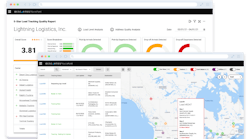Research conducted by the Virginia Tech Transportation Institute (VTTI) indicates that fleets can greatly reduce the risk associated with driver drowsiness and fatigue through the use of multiple technologies within the cab.
VTTI experts discussed fatigue and drowsiness along with safety system and driver wellness programs during a symposium last week. The event for fleet managers and insurance brokers was put on by Travelers Insurance and Northland Insurance in cooperation with VTTI and held at Travelers’ Claim University in Windsor, CT.
The VTTI and Travelers’ experts discussed topics with attendees that were selected through a VTTI poll of fleet managers, and focused on the impact of driver wellness, managing distraction, hours-of-service regulations and new technology on safety. Tours of Travelers’ Heavy Equipment Laboratory were also held.
“At Travelers and Northland, it is important for us to advance strategies that can help keep commercial drivers safer,” said Chris Hayes, director of transportation services, Travelers. “The goal of this program was to outline solutions to help fleet managers address their most significant concerns and improve overall driver safety. The research discussed was conducted by the National Surface Transportation Safety Center for Excellence, where Travelers and Northland work with VTTI to continue advancing the science of roadway safety.”
According to Dr. Gregory M. Fitch, senior research associate in the Center for Truck and Bus Safety at VTTI, 78% of crashes involve a driver not looking forward when the vehicle in front first applies its brakes.
“There are a lot of single measure technology out there,” Darrell S. Bowman, group leader for Advanced Systems & Applications at VTTI, told Fleet Owner. “What we found is that if you use multiple measures it’s more effective.”
These include not only forward collision warning systems, but also lane departure warning and even eye-glance technology which can mitigate the danger of drowsiness and fatigue.
“Technologies that rely on a single measure have some limitations,” Bowman added, “but if you can combine the systems, you can improve the quality.”
Bowman pointed out that dangers due to fatigue and drowsiness happen over time, giving the driver time to recognize the onset of these and make corrections, such as finding a safe place to stop and take a break or sleep. The problem, Bowman said, is that widespread use of technologies, such as eye-glance systems, has not occurred yet.
“The implementation of fatigue monitors has not caught on,” he said, adding that accuracy of such systems is a concern. “If the reliability is not there, there is going to be negative feedback.”
What Bowman said needs to occur next is what he called “data fusion.” This is the integration of technologies, either through cooperation among manufacturers or through a single manufacturer offering multiple systems.
This integration, which Bowman expects to reach light duty vehicles first and eventually migrate to commercial vehicles, can take advantage of all the data points inside the cab to create a safer environment for drivers.
Combating fatigue and drowsiness is just one area of concerns to fleets. Also on the radar of fleets managers are issues such as driver distraction. But while there are technologies such as cell phone blocking, lane departure and forward collision mitigation systems, it really is a carrier’s willingness to set standards associated with poor driving behaviors and follow through with enforcement of said policies that lead to reduced risk.
“The line of defense is always training and education,” said Dr. Jeff Hickman, a specialist in behavior-based safety research at VTTI. “You have to train your drivers but you can’t stop there. You may have a policy, but a policy is only effective if you enforce it.”
That enforcement can come through the use of onboard systems, such as a DriveCam or SmartDrive.
“It all comes down to enforcement,” Hickman said, “If there are no consequences, it doesn’t matter.”
Hickman said that research conducted by VTTI before the federal cell phone ban went into effect found that state policies on distracted driving had little to no effect on driver behaviors, but fleet policies did.
“There is not really a cookie-cutter approach, but there are steps you can follow,” Hickman said. “One is to specifically define what you are trying to enforce – cell phone policy, texting – and then define when there are [allowed] exceptions.
“And two, you need to have [consequences for violating the policy],” he added.
William McCory, safety director for Dunkin’ Donuts, told Fleet Owner that his company enforces a very strict distracted driving policy utilizing the PeopleNet system.
McCory said that Dunkin’ Donuts uses trial attorneys to conduct mock trials during safety meetings, putting a driver on the witness stand to face questions about violating company policies. No driver has ever “won” his case, McCory noted.
“They get a lot out of it because they see the consequences of their actions,” he said.
For its part, Travelers Insurance is doing what it can to reduce risk among fleets through its IntelliDrive fleet safety solutions. IntelliDrive utilizes telematics data to assist fleets in reducing accidents and associated risk, improve fuel efficiency and routing, reduce wear and tear on vehicles and reduce the risk of cargo or vehicle theft.
IntelliDrive is not a system, but rather a process, said Travelers’ Hayes. It is more an advisory service that utilizes the data compiled by most major onboard vehicle systems.
“We believe most fleets are cautious [about data] because it’s there information they are sharing,” Hayes said. “What we’ve found is if we leave the information to them [they are more trusting].”
Hayes said Travelers’ experts will review the data that fleets do choose to share under the program, analyze it and make recommendations on ways to proceed.
“We tend to focus as much attention as we can on driver and driver management and selection,” he added.
More information on IntelliDrive is available at www.travelers.com/intellidrivefleet.com.



